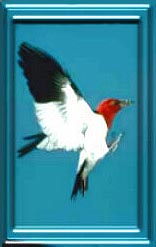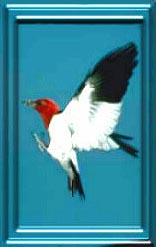 |
THE REDHEADED
WOODPECKER Melanerpes erythrocephalus |
 |
 |
THE REDHEADED
WOODPECKER Melanerpes erythrocephalus |
 |
| RED-HEADED WOODPECKER,
(Melanerpes erythrocephalus). The red-headed woodpecker is approximately10
inches (25 centimeters) long. The head and neck are red; the back, tail,
and upper wings are black; the lower wings, rump, and under parts are white.
They are most common in the southeastern United States, including the southern
parts of Texas in such places as Sam Houston State Park where the towering
pines make perfect homes.
When a woodpecker drums a tree, it is usually searching for food. Once it has detected the sounds of insects gnawing, or moving within the bark or wood, it begins to hammer persistently in pursuit of its prey. Trees are not injured by these birds; the disfigured bark soon heals. In fact woodpeckers save many trees from injury by insects. Woodpeckers, and their close relatives, the flickers and sapsuckers, belong to the large family Picidae. These birds are built for powerful hammering. Their strong claws grip the tree trunk firmly. The tail feathers are stiff and pointed to prop against the tree and brace the bird as it leans backward. The bill is thick and is driven by the powerful neck muscles. The woodpecker's unusual tongue is extensible and extraordinarily long. Its hard barbed tip is bordered with bristles. A woodpecker can use its sticky tongue for catching ants, as flickers do; as a brush for licking sap, as sapsuckers do; or as a lance to spear wood-boring insects. Woodpeckers have a distinctive galloping flight. They seem to clap their wings against their sides and bob up and down with each clap. They do not sing, but they have a variety of calls. Woodpeckers dig their nest holes in trees, often enlarging and remodeling a hole caused by decay. The male and female generally work together to prepare the hole. The female lays two to eight white eggs in a deep nest lined with sawdust and fine chips. Woodpeckers live in wooded parts of the world, except in Australia and New Guinea. They are most abundant in South America and Southeast Asia. They do not migrate long distances in the winter.
The pileated woodpecker (Dryocopus pileatus) is a shy bird of the heavy forests. It is found from southern Canada to the Gulf and from coast to coast. Because it lives in lonely, wild regions it is seldom seen by ornithologists or other bird watchers. It is 17 inches (43 centimeters) long, with a great scarlet crest. The ivory-billed woodpecker (Campephilus principalis), 20 inches (51 centimeters) long, is the largest North American species. It is near extinction because of the lumbering activities in vast southern United States forests that furnished it's food and breeding grounds, and because it has been illegally hunted. Recent sightings have been reported, and ornithologists remain hopeful that this species will survive.
|
© 1997 cowboyj@swbell.net
YOUR COMMENTS AND SUGGESTIONS ARE WELCOME..
This page hosted by
Get your own Free Home Page